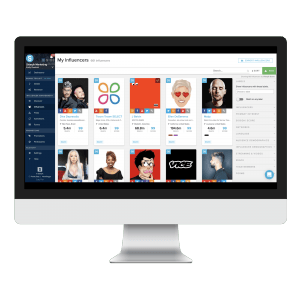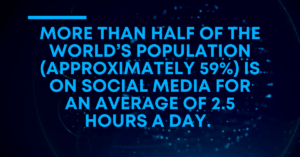Are you ready to take your influencer marketing to the next level, but overwhelmed by all the options for software tools on the market?
Most tools fall into two categories: an influencer network, or an influencer marketing platform. Both products can help you achieve your goals, but depending on many variables, one may be better suited for your brand than the other.
What is an influencer network?

Influencer networks are marketplaces that provide access to pre-vetted influencers for brands to connect with.
Influencers sign up to work with a network, and brands who work with that network have access to analytics regarding campaigns run within that single network of influencers. Some networks require influencers to only work with them, while others are more lenient.
By having influencers sign up, it means most social networks will allow the maximum amount of data about that influencer to be released. Some social media channels, like Instagram, limit what data is available to third parties unless an influencer has authorized.
What is an influencer marketing platform?

An influencer marketing platform, on the other hand, is robust software to help you organize ongoing influencer campaigns from start to finish.
Influencer platforms analyze influencers regardless of if they have signed up for the platform. Therefore, platforms have a much larger scope of discovery. Because influencer platforms are proactive in how they seek influencers, they can help you find influencers who are talking about important keywords or topics for your brand.
Inside a platform, you can search for relevant influencers without being worried about who’s in the talent pool. An influencer marketing platform should be able to find anyone talking about your brand. This can help you find influencers who are an authentic fan of your product or industry, so you know their followers are more likely to be interested in your product. This also enables you to create your own network.
What should I consider when choosing between influencer networks and an influencer marketing platform?
1. Speed
Are you looking to promote a product launching next quarter? Or do you need to boost brand awareness right now? Your timeline for launching your program will probably affect which kind of tool you need.
Networks can be quick to get the ball rolling. You can efficiently connect with influencers and have content out on social media in a short period of time. Since the number of influencers in a network is limited, there are only so many decisions to make.
If your brand is in any certain vertical, there are only so many influencers who fit that category. Therefore, discovery can be much shorter.
Also, because influencers have opted into the network, they already are hoping to work with brands. This means they’re ready to go when you need them to. Some networks even handle contracts and payments, meaning you basically just need to send an influencer guidelines and you have a campaign.
Platforms, on the other hand, can take longer to set up. With more in-depth vetting and discovery, it can be slower to establish your relationships with influencers. Not every influencer in a platform is openly soliciting brand partnerships, so things like contracts and payments may take longer to negotiate without a dedicated person managing the relationship.
2. Diversity of influencers
When you’re planning a campaign, does it matter to you if an influencer has worked with similar brands? What about competitors? If you only want a proven influencer who is experienced with #ad, a network is a great option.
There’s a sense of comfort in working with influencers who have a proven track record of driving sales, downloads, or social sharing. However, if you’re not comfortable with seeing your competitors in a social influencer’s feed, you may want to look outside of a network.
Because networks have limited talent pools, other brands — including those you’re competing with – may be fishing in the same pond. And while obviously, you can just look for a network where your competition isn’t, it is something you need to consider before signing up for a network plan.
On the other hand, a platform can help you unearth a wider range of influencers. And if you have a good idea of who your fans are listening to and what they’re talking about, you may actually be able to find an influencer who is a more authentic fit for your brand.
By working with an influencer that is more genuinely aligned with your brand’s values, you can increase your connection with fans and feel a little less like #sponcon.
3. Relationships
With networks, influencers have signed up to work with that network. That relationship is owned by the agency through which you are sourcing talent.
If you plan to have long-term relationships with influencers, it may be worthwhile to work with them through an influencer relationship management platform, to keep those connections in-house and maintaining your partnerships in house.
If you are looking for a one-time promotion, maybe having a network be in control of your influencer is easier.
4. Budget
If your influencer marketing budget can barely cover the cost of shipping product to an influencer, the cheaper technology solution is always going to be a network.
Since networks are databases of influencers, they don’t have the kind of robust analytics you can find in competitors. Network fees range from a few hundred dollars a month to a percentage of what you’re paying influencers. And while the sticker price is low, it doesn’t give you much.
Effectively you’re paying for the privilege of seeing what influencers the network works with. Influencers within that network will have set per-post or per-engagement pricing in addition to the network fees.
On the other hand, while a network may keep upfront costs low, they provide only a limited pool of influencers, social media networks, and analytics capabilities. Also, working with influencers in networks can make actual influencer contracts more expensive since many networks take a cut from what you’re paying the influencer.
Influencers on Instagram reportedly charge around $1,000 per 100,000 followers. And you know an influencer who is advertising on a network has set fees in mind. Using a platform to find an influencer who already likes your brand may end up saving you cash, even if the technology costs more.
What are your influencer marketing KPIs?
When deciding between using an influencer marketing platform or an influencer network, it’s important to know exactly the kind of campaign you want to run.
First, identify the goal of your marketing campaign. Do you want to boost brand visibility? Drive sales? Increase social engagement? All of these goals have different influencer marketing KPIs. As discussed above, what you focus on could help you determine which tool to use.
Regardless of whether you need a network or a platform, there are benefits to partnering with a technology tool beyond what you could do in-house. By using either a network or a platform, you are keeping influencer management in a single repository making it easy to work across teams.
And in terms of measurement, social networks divulge much deeper analytics to technology partners than you would get from manual reporting.
Overall, networks are easy to set up and a great option if you’re early on in your influencer marketing journey. However, they can be lacking when it comes to unique discovery and in-depth analytics.
If you’re in need of demographic information, niche influencers, or just a fresh crop of talent, maybe something else is more in line with your needs.
If you’re leaning toward a platform, Sideqik is the premier influencer marketing platform for brands looking for informed social engagement measurement.
Fueled by our team’s expertise in social engagement, Sideqik is the only end-to-end solution that enables brands to find relevant influencers and activate consumers in a meaningful way – taking you from discovery through to engagement to grow your brand. If you think a platform is a better solution for your business, schedule a live demo today.







